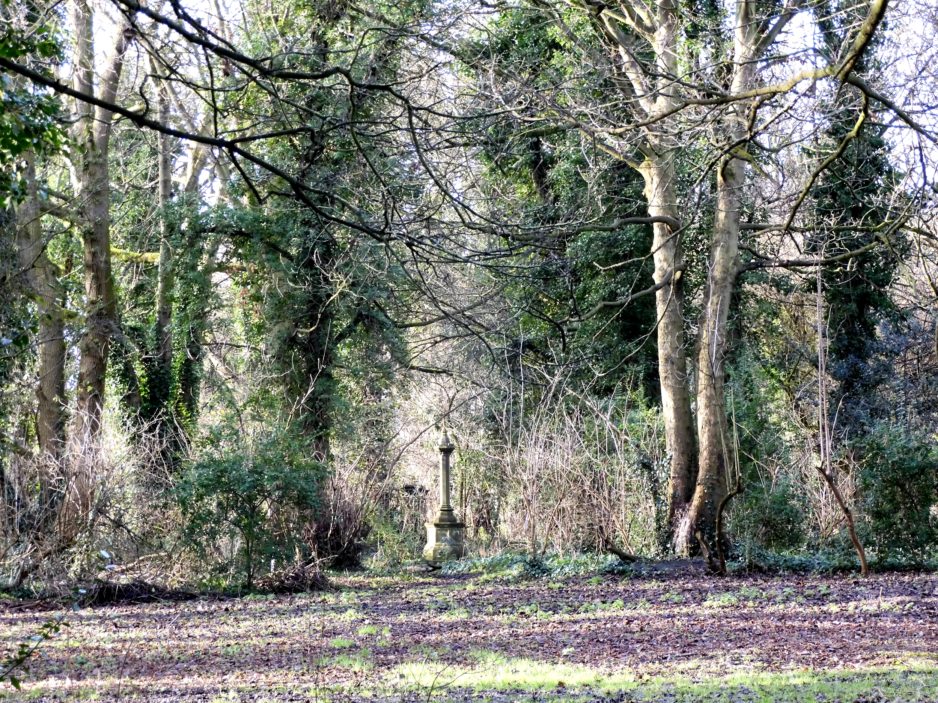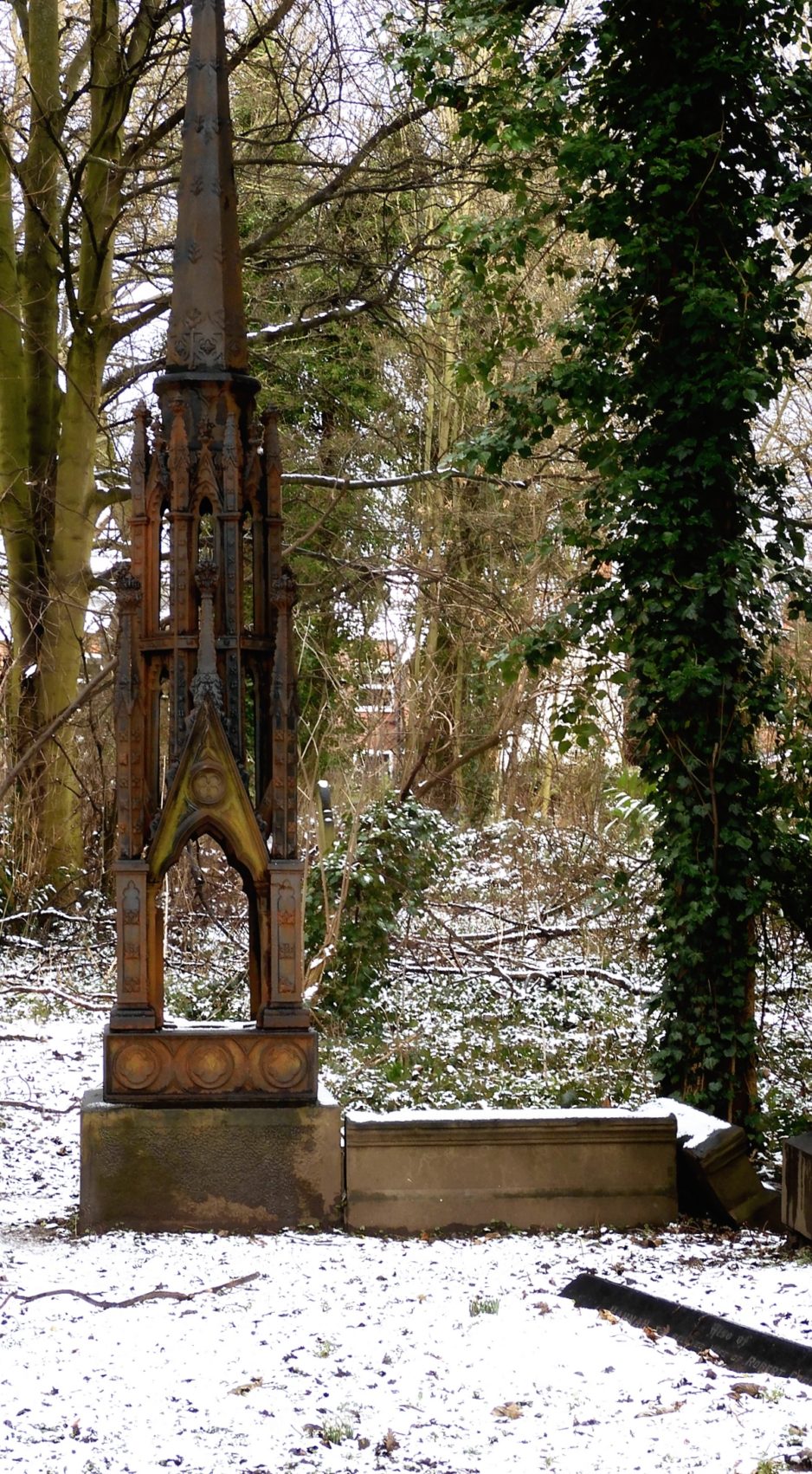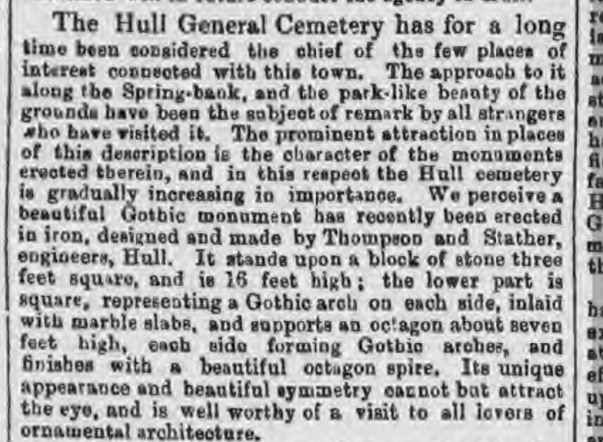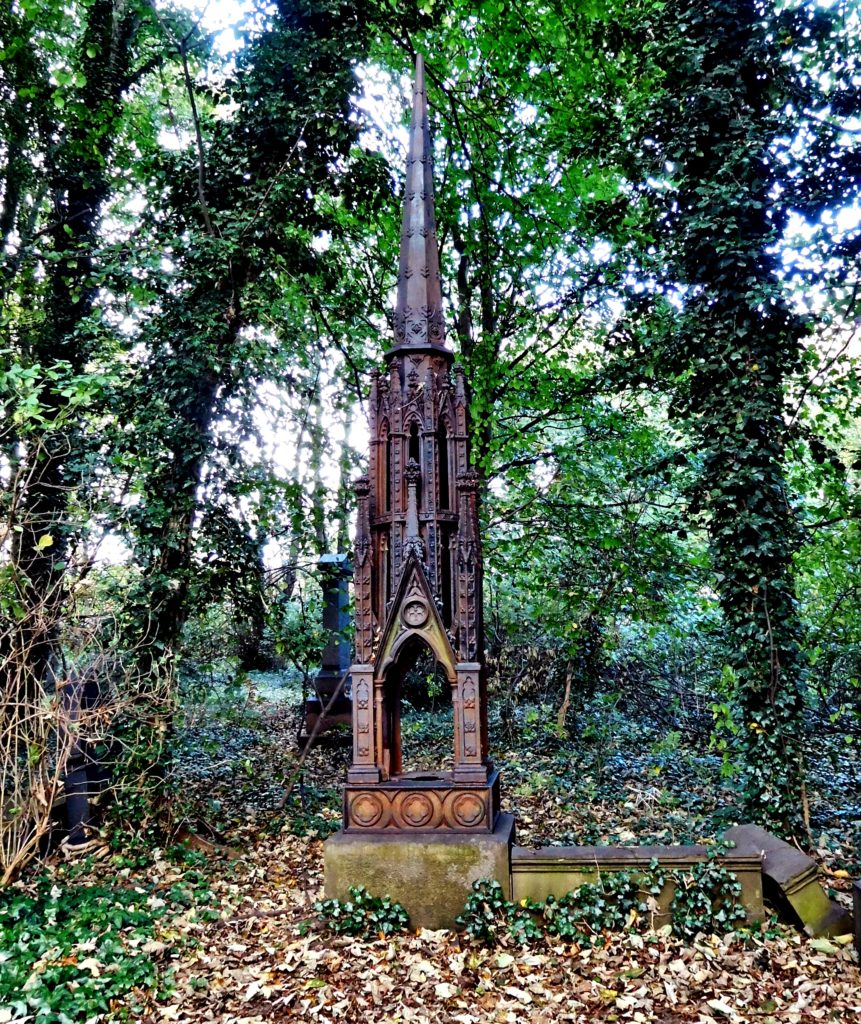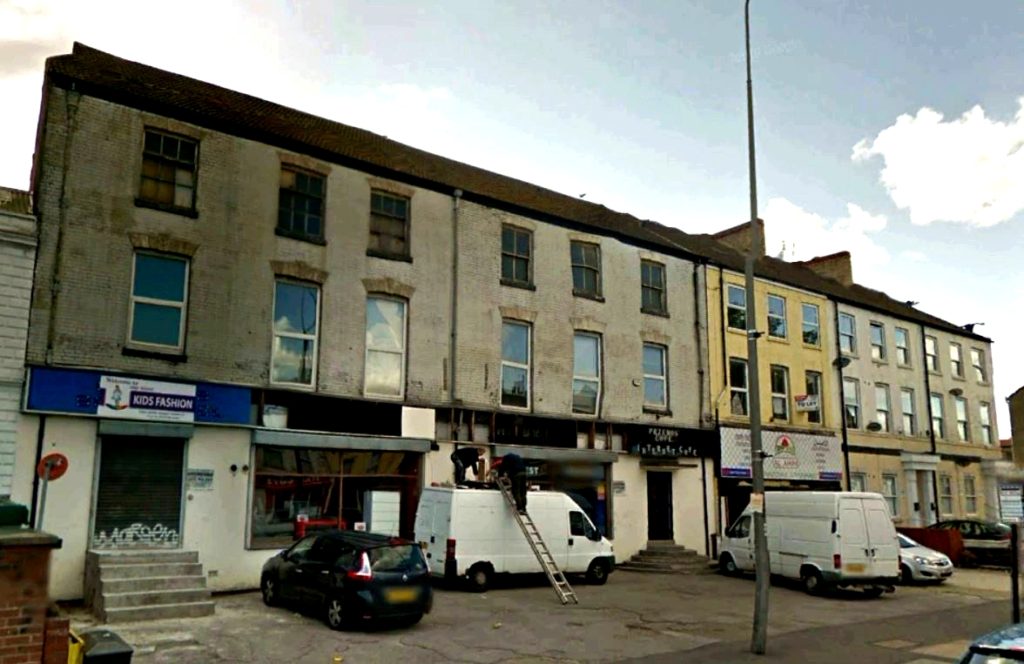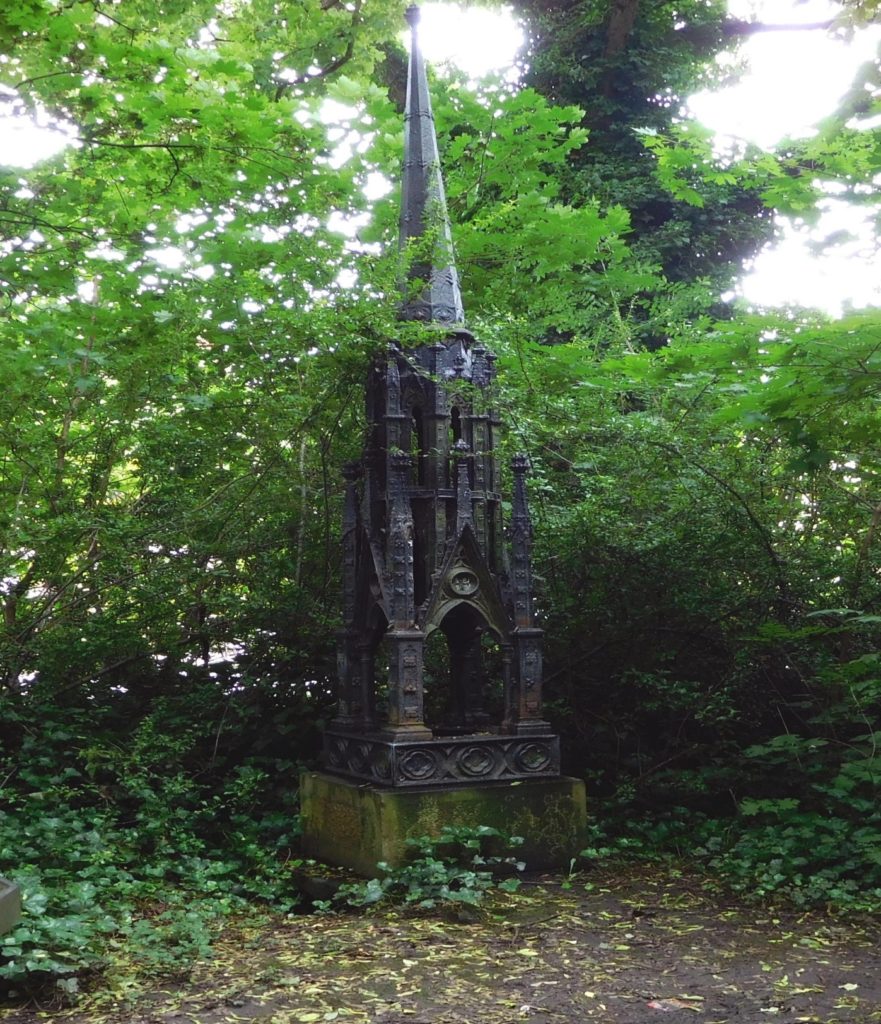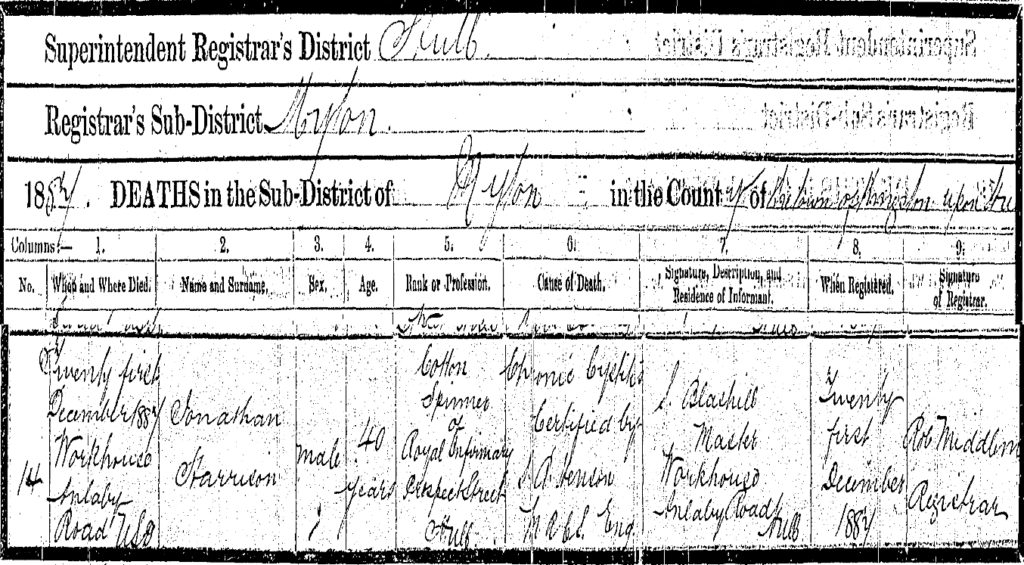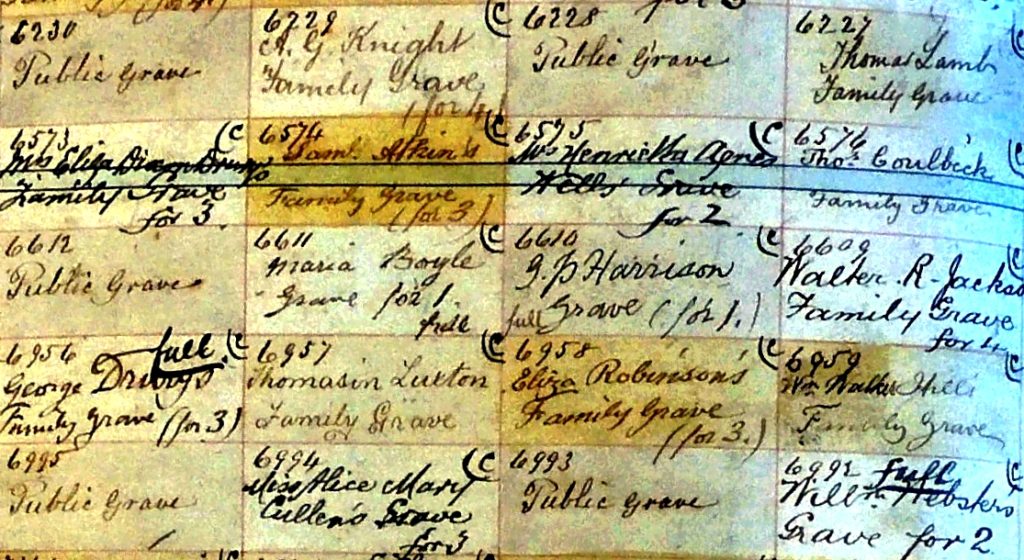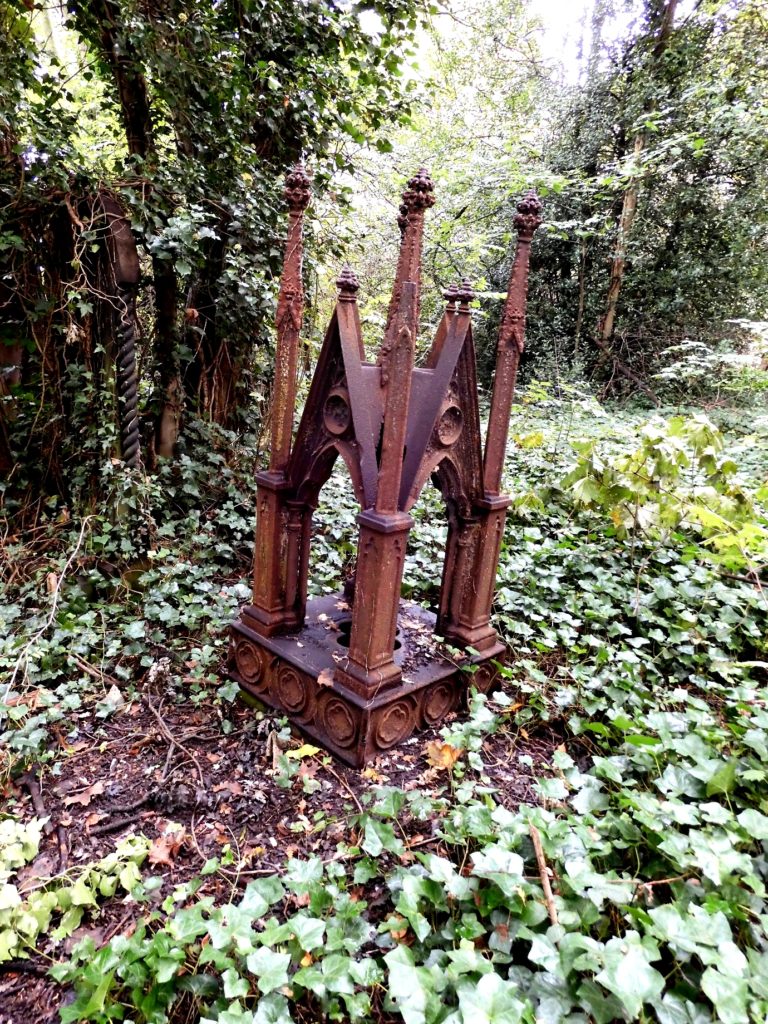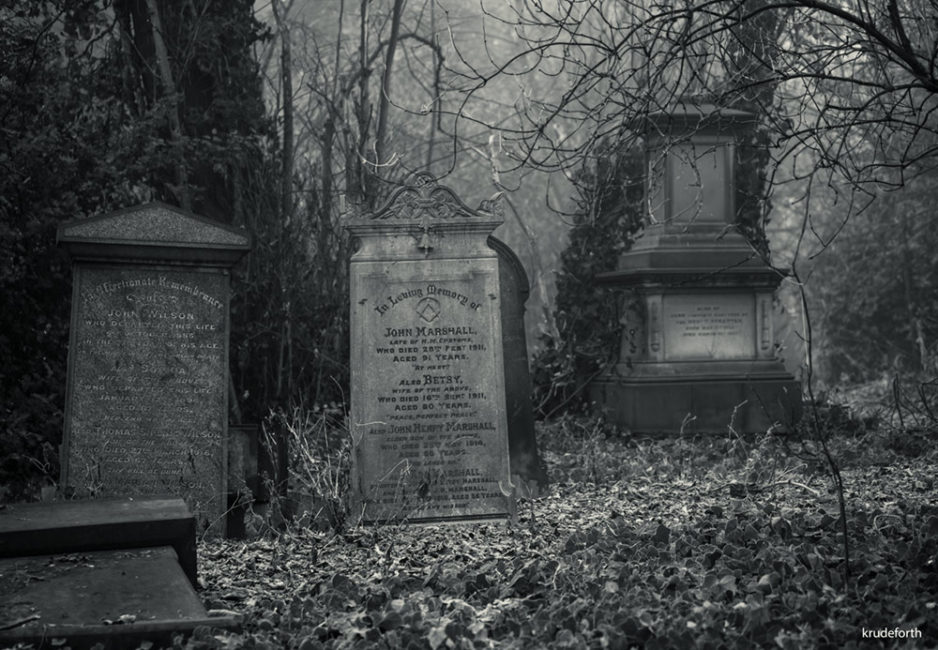The context of the story
This is the third and final part of ‘the Creation of Hull General Cemetery. As I said at the beginning of the first part it was originally written in 2015. It was published in the Hull Civic News in 2016/17. I’ve tweaked it and enlarged parts of it here. I can do that here without worrying about ‘how can I fit that on the page?’ or ‘that image is in the wrong place’. However, in the main, it’s the same story that I originally wrote. That’s why, at the end, there is the reference to Hull City of Culture. For when I wrote this, that was still in the future.
As we know Hull General Cemetery played a small part in that pageant. It was used as a backdrop to some acrobatics. The cemetery itself was used as a low-rent Hammer House of Horrors setting. No effort was made to highlight the architecture or culture artefacts in there. No attempt was made to hold up to a wider audience the history of the site.
Post 2017
Here we are now, four years after that whole cultural festival year, and one year after it officially ended. The heritage aspects of the cemetery are still under threat. From indifference on the part of the Council with regard to the irreplaceable heritage aspects of the site to a group of people who ‘know’ that they are right and who feel that a Sycamore is more important than the headstone of the first woman photographer in Hull. History was seen as important by all groups when the City of Culture was in full swing.
Now, in a place where it is most vulnerable, it is under attack. A short sighted view. The site is big enough for both heritage and nature but right now the pendulum is far and away on the ‘nature’ side. A little appreciation of the valuable assets that can be lost forever if we don’t take some care now is imperative.
Culture Wars
There’s a great deal of discussion lately about ‘culture wars’. There’s one taking place right now in the Hull General Cemetery. I know which side I’m on.
Anyway I hope you enjoy this final part of the site’s beginnings.
The first shareholder’s meeting
On the 21st November 1845 a full general meeting of shareholders was undertaken. Amongst other things, this meeting voted to allow the directors of the new company to raise a loan for £5,000, as the land from Mr Broadley was for sale at £6,000. This loan would have allowed the Company to act on this purchase without straining their shareholders.
It was fine establishing a Cemetery Company but a cemetery needed land to pursue its business. That was the next task at hand.
In early December the Directors of the Company reported in the local press that,
‘upwards of 150 of their townsmen are already subscribers to this intended beautiful and well-ordered place of undisturbed repose for the Dead of all classes of this large community.’
The land for the proposed Cemetery were two pasturages. These were situated at the crux of Newland Tofts Lane or Princess Bank, as it was sometimes known as, and Spring Bank leading westwards. This part is now known as Spring Bank West.
The site was owned by Robert Wood in the last decades of the eighteenth century. It had been farmland since the medieval period when it had been drained by the creation of the Julian Dyke in 1404. The land passed to Robert Carlisle Broadley in 1804. By the time the Company were trying to buy it Henry Broadley appeared to own it.
Copyhold
A meeting took place between Mr Thompson and Mr Irving for the Company and Mr Broadley at Beverley in mid-January 1846. The sale of the land had already been agreed but this meeting was about the enfranchisement of the land. It appeared that Mr Broadley owned the land yet it was ‘copyhold’ land. Mr C.S.Todd had been informed of this development late in December 1845 and had informed the Directors. Yet another unforeseen cost to the Company.
Copyhold was probably one of the last vestiges of feudalism.
Wikipedia explains
It is best explained by this Wikipedia entry;
‘The specific rights and duties of copyholders varied greatly from one manor to another and many were established by custom. Initially, some works and services to the lord were required of copyholders (four days’ work per year for example), but these were commuted later to a rent equivalent. Each manor custom laid out rights to use various resources of the land such as wood and pasture, and numbers of animals allowed on the common. Copyholds very commonly required the payment of a type of death duty called an heriot to the lord of the manor upon the decease of the copyholder.’
The cost to the Cemetery Company
These legal duties were eventually phased out over the nineteenth century. However at this time the landowners were still gripping such vestigial rights tightly.
In this instance the manor was Cottingham and the Company would need to pay a significant sum to the Lady of the Manor. Mr Broadley, in recognition of his ‘error’, offered £100 towards this enfranchisement cost. Later still this sum was increased to £250. Perhaps this shows how much the sum involved was. The final cost was £529 7s 6d to the Company.
On the 4th February 1846 a conveyance was agreed. The parties being Henry Broadley and the Board of Directors of the Company. These were John Solomon Thompson, William Irving junior, Thomas Abbey, Charles Stewart, Benjamin Ansley Tapp, John Malam, and George Robinson. The cost of this conveyance was £5,566 5/-. This was to be paid back in annual instalments over five years at an annual rate of interest of 4%.
Making enemies
By December 1847 this debt had been reduced to £4,489 10s 4d and that is where it stood for the next six years. The Company failed to pay this debt off during Henry Broadley’s life time. His sister Sophia, who had inherited Henry’s property, agitated for this debt to paid off. It was finally paid in 1853. Once again, through stupid self-interest or possibly lethargy, the Board had made an enemy. Sophia would be instrumental in providing the land for the the Division Road Cemetery in the 1860s. Once again the Company had provided the impetus behind a serious competitor for custom.
Changes afoot
Meanwhile back in 1846. The Board was influenced by a visit Mr Thompson had made to Kensal Green Cemetery in London. From this visit he was intent upon making the Cemetery as splendid as it could be. The Board agreed.

In February an advert for designs from architects was placed in the local press. This finally showed that the cemetery would become a fact of life rather than just an aspiration. The Hull Advertiser noted this in an editorial of the same edition that began with the words,
‘It affords us no little satisfaction to notice the actual commencement of operations for carrying out this long-needed improvement.’
Promenade…again
The same article went on to say that,
‘The site, running parallel with the Spring Bank, is well chosen; and a delightful promenade, by improving the present bank and the road in front of the Old Waterworks, might, with a moderate outlay, be provided for our busy population; in fact the whole of the road from the Zoological Gardens to its termination at the entrance gates of the intended cemetery, is capable of being made an attractive adornment to the town.’
The idea of the promenade would linger on until Mr Garbutt took it in hand some 30 years later with his Avenues project and General Cemetery would play little part in that plan.
The Cemetery moves from being a hope to a reality
The Hull General Cemetery was fast becoming an established fact. It was soon to exist to cater for the town of Hull.
The winner of the competition to design the Lodge and Chapel for the Cemetery was a young architect called Cuthbert Broderick. The story of the Lodge and its history will feature as another article later this year.
In the April the Directors had invited the shareholders to look at the designs for the laying out of the cemetery grounds. By the 8th May the designs for the cemetery buildings were approved unanimously by the Directors with Cuthbert Broderick being hailed by the press as, ‘our talented young townsman.‘
In this month too a war of words with the Holy Trinity Churchwardens had apparently been amicably settled. This spat had erupted due to the fact that the church would only receive the minister’s fees for officiating at a service in the Cemetery. When they opened a grave in Holy Trinity churchyard or the Castle Street burial ground the costs of the burial were collected by the church. A meeting between the Directors and the Churchwardens appeared to resolve this issue.
John Shields
On the 13th August 1846 it was noted in the minute books that John Shields had approached the Board as to his employment by them.

This was coup of the first water. Here was an experienced cemetery superintendent asking for work. Not only that but York General Cemetery was held up as a model of planning and efficiency. Here was a great chance for the Company to progress further with an an astute guiding hand helping the Board.
You may be surprised to know that, for once, the Company did the right thing. The Board unanimously approved the appointment of John Shields as the first superintendent of Hull General Cemetery at the board meeting of 26th September 1846. His salary was £90 per annum and the Board would pay for his accommodation until the Lodge was available. After that he would live rent free on Company land. He would remain as the Cemetery Superintendent until his death in the 1860s.
His first job
At that very meeting when Shields was informed of his appointment he was also given a number of tasks.

As you can see, he was instructed to mark out the ‘first field’. The site, as you know, was divide up into two fields for the purposes of pasturage. The first field ran from, what is now Princes Avenue up to just past where the Cholera Monument stands.
The second field would eventually contain the Quaker burial ground, the Workhouse mound and the 5 acres that were eventually taken by the Hull Corporation for Western Cemetery. The approximate dividing line between the two fields is marked by the drainage pit in the Quaker plot.
He was also asked to cost the hard core he would need to use for the laying out of the paths in the Cemetery as well as attend to the Newland Tofts drain. The Board wneeded his expertise and knowledge. The local press were not slow in recognising what a find John Shields was for the Cemetery.
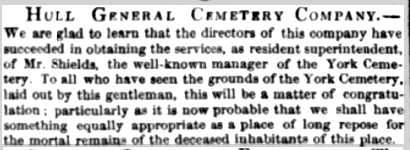
The Deed of Settlement
It would have been easy for the Company to have taken its eye off the ball though and miss out on John Shields. Other matters were pressing.
The Board were concerned at the delay in receiving their Deed of Settlement from the Registry of Companies in London. Without this deed much of what they proposed to do was technically illegal. The solicitor C.S Todd was often moving back and forward between London and Hull during this summer.
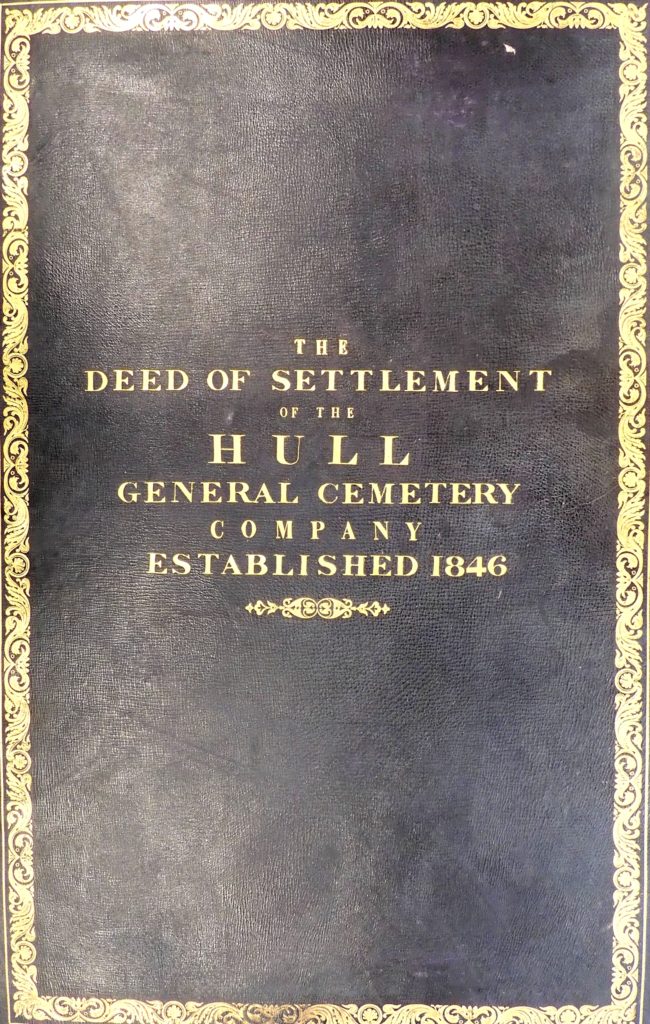
Eventually the precious document was received. This news was quickly advertised in the local press. The Hull General Company now existed in reality. It now owned the land for the Cemetery. It was progressing with the drainage and laying out of its grounds. Finally, the Company was registered as a corporate entity. In essence it could now begin to exercise its reason to exist; the burial of the dead.

Cottingham Drain
Running concurrently with all of this was a step undertaken by the Company to tender a contract to widen and deepen the drains and to join them to the Cottingham Drain. This was an ambitious undertaking.
Not just by the length of the scheme, but that the tender specified that the drains would be, ‘brick-barrelled’. This would obviously cost more than simple soak away drains or cuttings. The remains of the Cottingham Drain may be seen still as the grass verge running parallel with Queen’s Road.
Culverted and covered in the mid 1960s it still empties into the River Hull close to the High Flags point on Wincolmlee. You used to be able to see it from Scott Street Bridge but with the removal of that bridge that sight has gone forever..
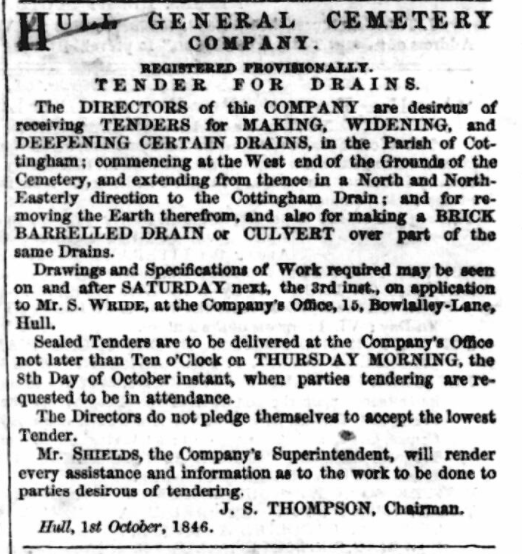
The lodge, chapel, trees and shrubs
The same day tenders were appearing in the local press for the construction of the lodges and the chapel. The following week tenders for supplying ‘ornamental forest trees’ and,
‘evergreen and deciduous shrubs, sufficient for planting and laying out of the grounds of the company’.
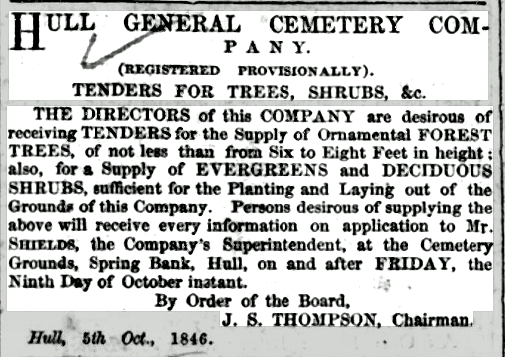
Later that same week the contract for the draining work was awarded to Mr. Benjamin Musgrave. The tender for the erection of a temporary cottage was given to Mr John Darley. The cottage was for the purposes of a night watchman. Theft was just as prevalent then as now, whatever people say about the ‘good old days.’ In September a spade was stolen from the grounds.
All of this industry was recognised and applauded in the local press. On the 23rd October the tender for the provision of the fencing of the site was advertised for. The press reported that,
‘the directors do not pledge themselves to accept the lowest tender’.
This implied to the eager public that the Company desired quality as it had in all other aspects of the development of the Cemetery.
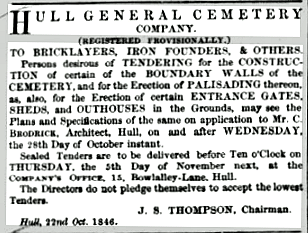
This ‘desire for quality’ did not last. When the estimate for building a wall around the cemetery hit the Board’s table it was found expedient to go for fencing instead.
The same day that the fencing tender was advertised it was reported that a trial grave had been dug on the site. Some 8-foot-deep, it had been excavated to test the drainage and that it was “thoroughly dry”.
It was also reported that only 63 shares were left to purchase by future subscribers. It was stated that any subscriber could either have their share as an investment or relinquish it for a vault in the cemetery in lieu of their subscription. Over the lifetime of the Cemetery may shareholders cared to do this.
Progress
An extraordinary meeting of all shareholders took place on the 26th November 1846. This was to ratify a number of issues that the Directors of the Company had undertaken. One of these issues was the agreement with Holy Trinity Parish to sell some of the Company’s land to the joint parishes of Holy Trinity and St Mary’s. The land identified would be consecrated and encompass about 10 acres at the western end of the Cemetery. This agreement met with approval by the shareholders.
The Company had no idea what trouble this issue would lead to.
The meeting was also a time for the Directors to acquaint the shareholders with the progress they had made on their behalf. The temporary cottage was to be erected at a cost of £70. The contract for draining the cemetery grounds was settled on the sum of £159 6/- whilst the outer draining was contracted to be £400. A well was sunk in the work yard.
The erection of a pump house and installation of a steam engine for the maintenance of the draining of the cemetery was contracted for £195. The chairman, Mr J.S. Thompson, thought this, ‘is one of the cheapest things I ever met with.‘
Holy Trinity burial space
Backtracking slightly, a week before this extraordinary meeting, a public notice had appeared in the press. It was placed there by Charles Frost. Charles Frost was a noted Hull historian, second only to Sheahan in my eyes. He is also buried in Hull General Cemetery and his headstone was destroyed in the ‘clear-up’ of the 1970s.
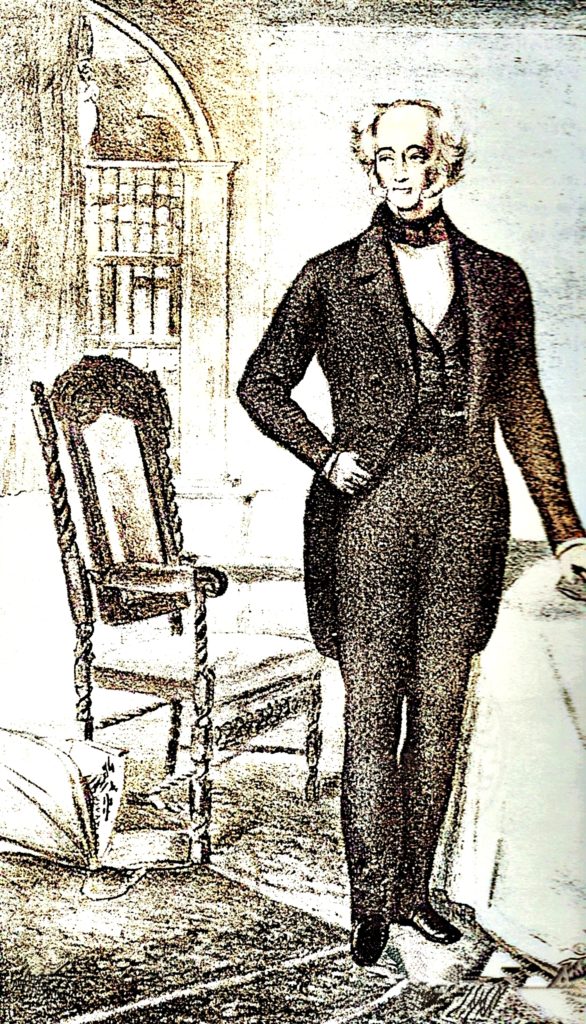
He was acting as solicitor for the Church Wardens of Holy Trinity Church. The notice was informing the public that the church was seeking an Act of Parliament. By this Act they were hopeful of selling Castle Street burial ground and purchasing the westernmost 10 acres of the Hull General Cemetery.
Castle Street burial ground to be sold
One has to wonder who on earth would want to buy Castle Street which at that time was simply a large cess-pit of the dead. One also has to wonder at the temerity of the Church to even consider doing this. With little or no thought for the parishioners or their loved ones who they had buried in there.
This very idea shows how the Church at that time viewed the disposal of the dead and why the Hull General Cemetery was so needed. The Church put forward the idea that the bodies would be exhumed and re-interred but the families would not be consulted on this.

When the press reported the Extraordinary meeting of the shareholders of the cemetery it was this point that was deemed to be the most important.
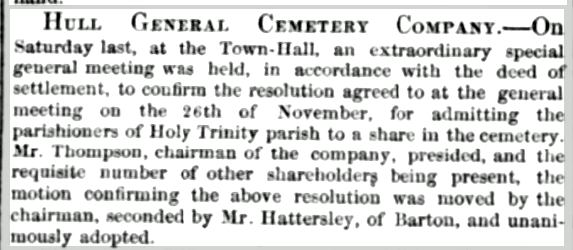
Not the Promenade again!
On the 18th of December the old chestnut of the Promenade surfaced briefly in a letter to the Hull Packet from “A Pedestrian” in which he stated that improving the south side of Spring Bank by the Council would provide,
‘a pleasant walk of about half a mile, with two interesting objects in it, viz the Zoological Gardens and the new Cemetery.’
The correspondent then went on to say that his scheme would be to,
‘buy land from the Cemetery northwards, including all Tofts Lane to the Cottingham Drain, and make that into a handsome promenade.’
That this actually occurred some 30 years later shows that this idea did not simply originate with Mr Garbutt when he laid out the Avenues.
The church starts to get cold feet
All was not plain sailing for the Cemetery Company though. In February 1847 the plan that had been agreed upon with the Churchwardens of Holy Trinity for the church to have the western end of the Cemetery came to an abrupt end.
The vicar and his wardens disagreed between themselves who was to fund the £100 needed to present their Act of Parliament to the appropriate parliamentary committee.
Eventually one of the Churchwardens, a Mr Mitchell, felt duty bound to put sureties, with provisos, for the £100 up himself. He stated that he still felt that the vicar had acted in bad faith.
This, however, would not be the end of this matter.
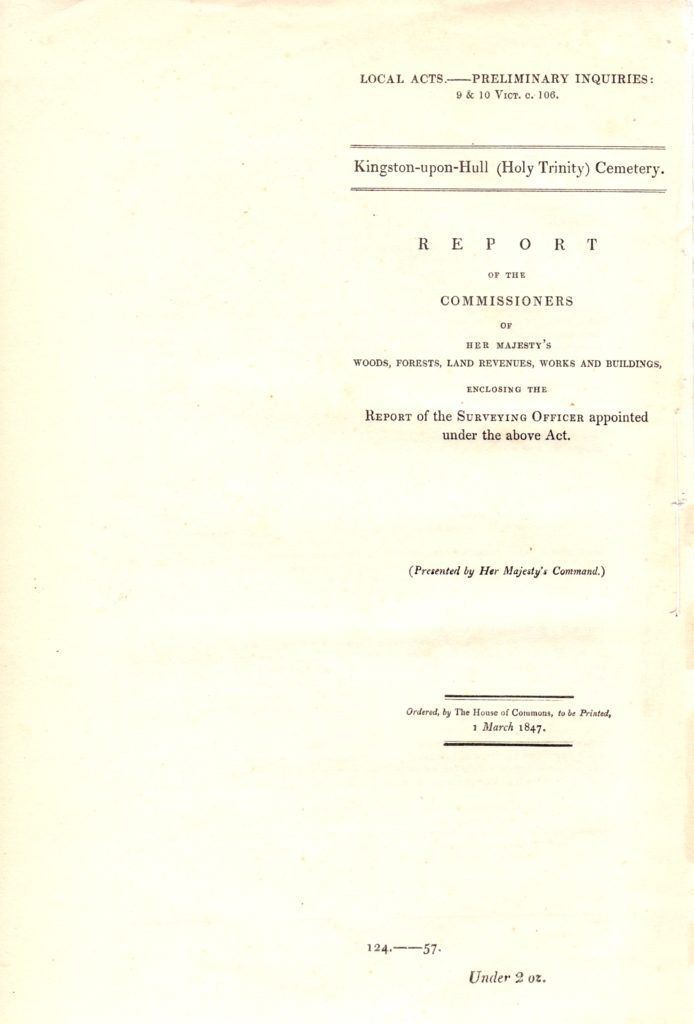
Enter the Government Surveyor
On the 29th January 1847 the Surveying Officer for the parliamentary committee, George Hammond Whalley, gave notice in the local press that he would be surveying the site of the cemetery on the 10th February. He would also be inspecting the other burial places in the town.
As part of his role he would be conducting a hearing with interested parties on this issue.

The Hull Advertiser Editorial
On the 4th of February the Hull Advertiser ran an editorial. It occupied almost one full page.
In this piece, it was obviously troubled by what it thought was a degree of duplicitous on the part of the church. It would be proved to be correct.
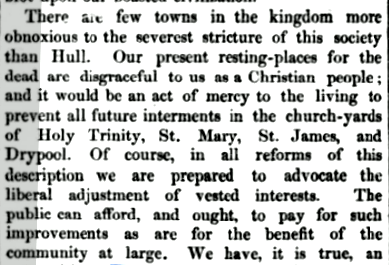
The editorial warmed to its task. It cited horrific sights in supposedly holy places.

The editorial also flagged up the prospective Act of Parliament devised by the church authorities although it appeared to not hold much faith in it.
It also informed the public of the intended visit of the surveying officer and the reason for his visit.

And finally, it pointed the way forward using the example of the Hull General Cemetery as a solution.

The surveyor did not attend on the 5th but attended on the 12th of February. He inspected not only Holy Trinity burying ground, the vaults of the church but also the cellars of the house in King Street that abutted the burial ground. He also visited the site of the new cemetery. Not that it did him much good.
The night before his visit and his hearing for the proposed Act of Parliament. a disaster waylaid all the plans. A man-made disaster and based solely upon money.
Disaster
The next day, in quite measured tones, The Hull Advertiser advised its readers that the necessary Bill in parliament to grant the necessary Act of Parliament to set up the part of the cemetery that was to be religiously endowed was dead.
At an impassioned and rowdy parishioners’ meeting the day before, the resolution to apply for the new Act to set up this cemetery was voted down by angry parish members who did not want to increase their church rates.
At 3.00 p.m. on the day of his inspection the Surveying Officer was informed of this decision and refused to hear any further evidence on the subject. In fairness to him there was no point in continuing the hearing. The hearing had been expressly called for by the proposed Act. With the idea of the Act dead in the water his role was effectively complete.
John Solomon Thompson doesn’t miss his chance
It didn’t stop the Company representative, John Solomon Thompson, from extolling the virtues of the Cemetery. The Surveying Officer was impressed with the site and said so in his report but this had no bearing upon the proposed Act brought by the Church authorities.. Charles Frost, placed in an invidious position, could only say to Mr Whalley that he could not present any evidence in support of the Act. Mr Whalley therefore concluded the meeting and left the town.

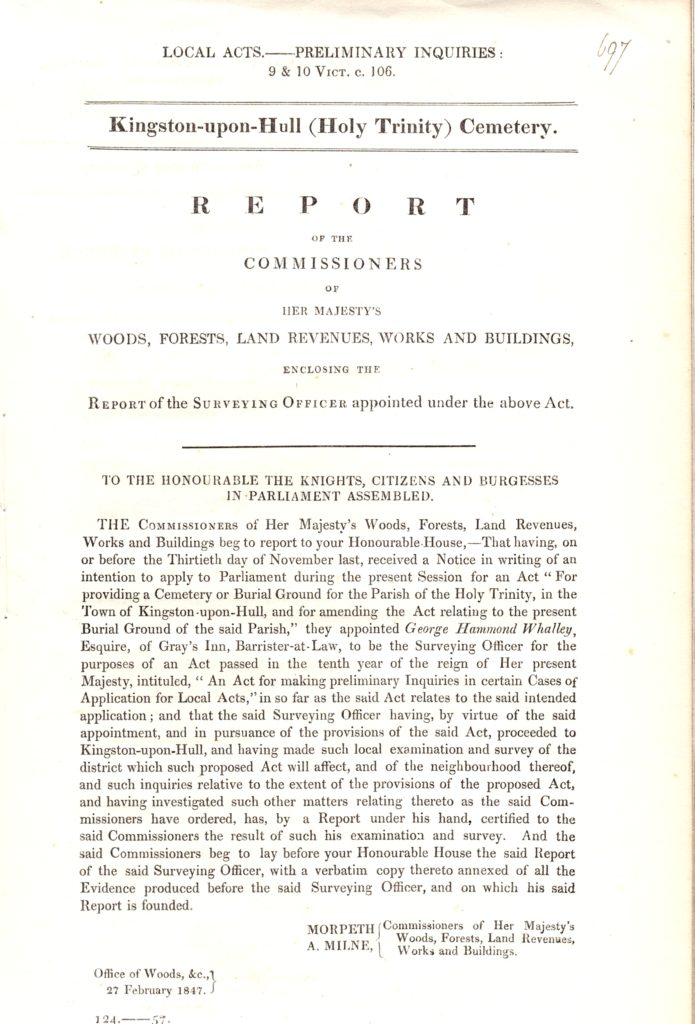
Never trust the church
The Cemetery Company now showed that they had had enough of dealing with the religious interests. They would not enter into any further agreements with the churches as to leasing or selling them any land.
This meant that when the burial grounds were closed in Hull by Order in Council in 1855 Castle Street was granted an extension. By 1860 it was ordered to close by the Inspector of burial grounds.
Once again it was given an year long extension because it was close to providing a new burial ground. It closed in December 1860. The new burial ground was Division Road.
On the 18th February the Company gave notice to the occupier of the second field of the site. They were now showing that they would use the whole of the site for their own purposes.
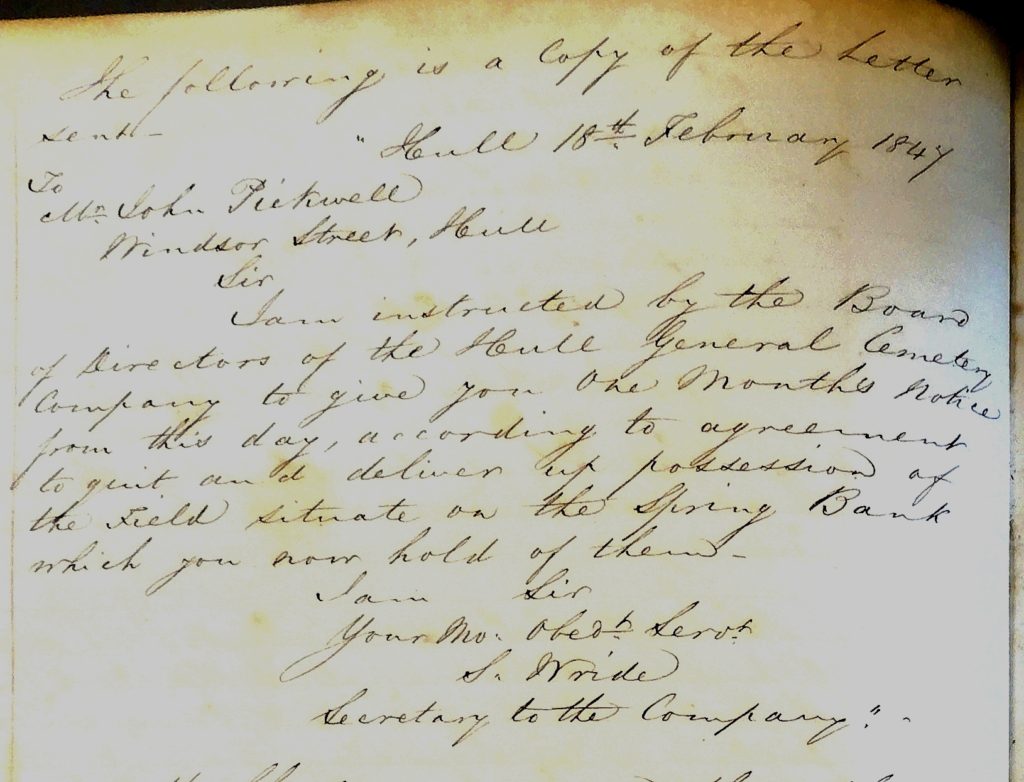
Another shareholder meeting
There was general shareholder meeting on the 5th March 1847. The progress that the Cemetery Company had made was laid out to the shareholders.
The drainage works was now complete on the site. Both the Spring and Derringham Ditches had been widened and deepened and this work was almost finished. The fencing off of the site was almost complete. The laying out and planting of the ground were proceeding.
Finally, the chairman brought the shareholders up to date by mentioning the recent visit of the Parliamentary Surveyor,

In late March the Hull Advertiser paid a visit to the site and commented favourably on it, stating that there were,
‘Already upwards of 3,000 ornamental trees, deciduous and evergreen and shrubs, have been planted, together with 100 of the newest and best sorts of standard roses.’
It also said that a temporary chapel had been constructed until the more permanent one could be built. In April the tender for contracts to erect the lodge and entrance gates were advertised in the press.
The first interment?
On the 16th of April the first interment, that of the child of a Mr Smith, a draper of the firm Marris, Willow and Smith in Whitefriargate, took place.
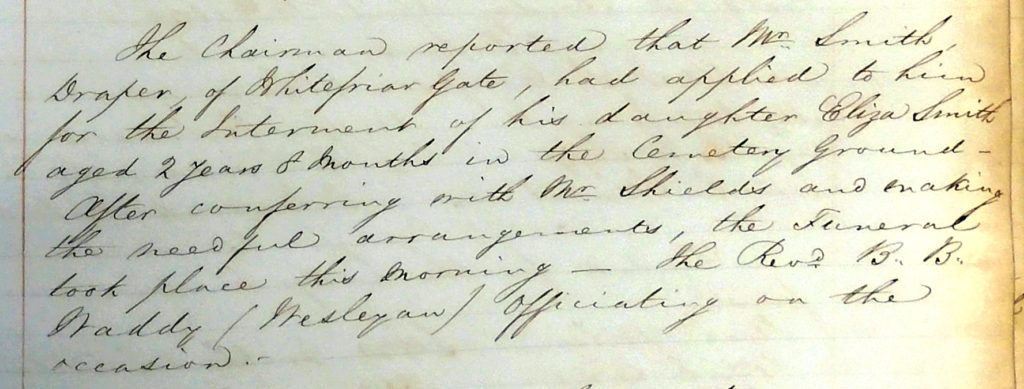
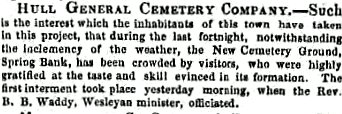
There is however, another story here. For those of you who have seen the first page of the Burial records of the Cemetery one thing stands out. The second burial recorded took place before the first one.
How could this happen?

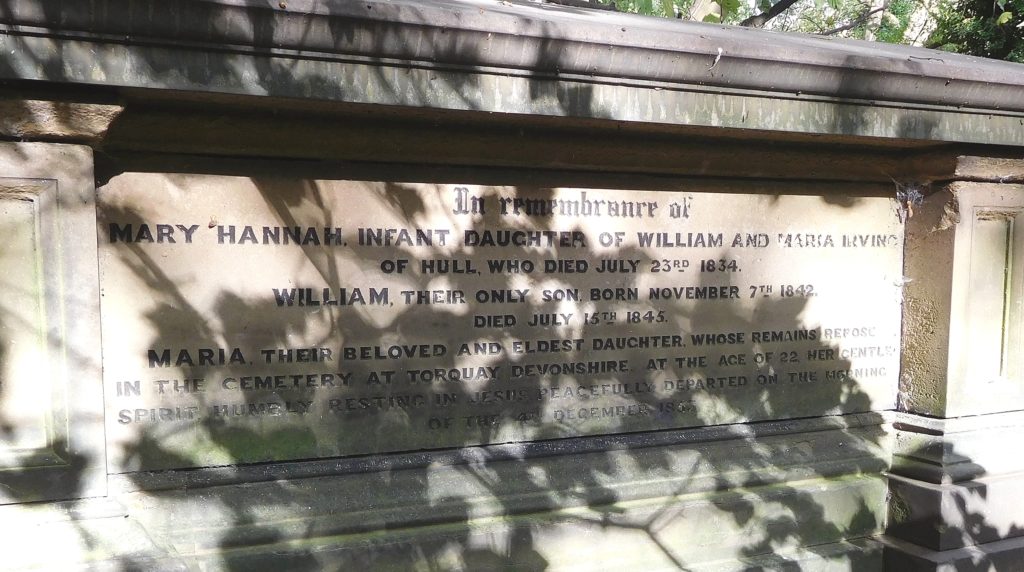
The second burial, that of William Irving, was a re-interment from Fish Street Chapel. This took place on the 14th April. William Irving was one of the founder members of the Cemetery Company. He was the first chair of the Provisional Committee, and he took over as the Chair of the Company later when John Solomon Thompson resigned.
This re-interment may have been planned well in advance. For instance, the brick lined vault would have needed to be excavated and built in preparation for the child’s remains. William Irving may have probably been hoping for the ‘glory’ of having the first burial taking place in the Cemetery.
Imagine his chagrin when Thompson arranged with John Shields to have Mr Smith’s daughter interred so quickly.
The local press made amends though.

A real promenade
The Cemetery was also becoming a place to visit. Hull, at that time, had no public parks where you could while away the time. The Botanic Gardens, established in the early nineteenth century, were available. At least to those who could afford to pay the entrance fee. As was the Zoological Gardens but the entrance fee was still a drawback to the poorer classes.
The Cemetery, however, was free to enter and enjoy – if that’s the right word here. The Company had spent a considerable amount of money on landscaping and it looked like the townspeople were appreciative of it.
On the 23rd April, the day before the article above, a long-awaited advert appeared the local press.
It announced that the Hull General Cemetery Company were proud to say that the cemetery was, ‘now ready to receive interments.’ The advert went on to say that the rates for their services would be published soon. And they were. 10,000 copies of them too!
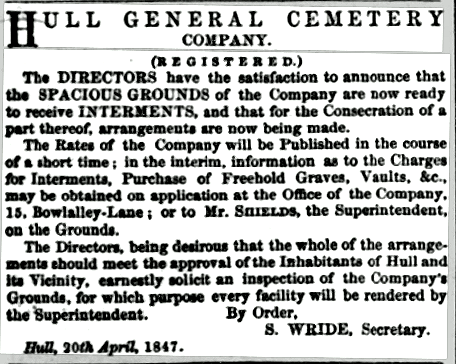
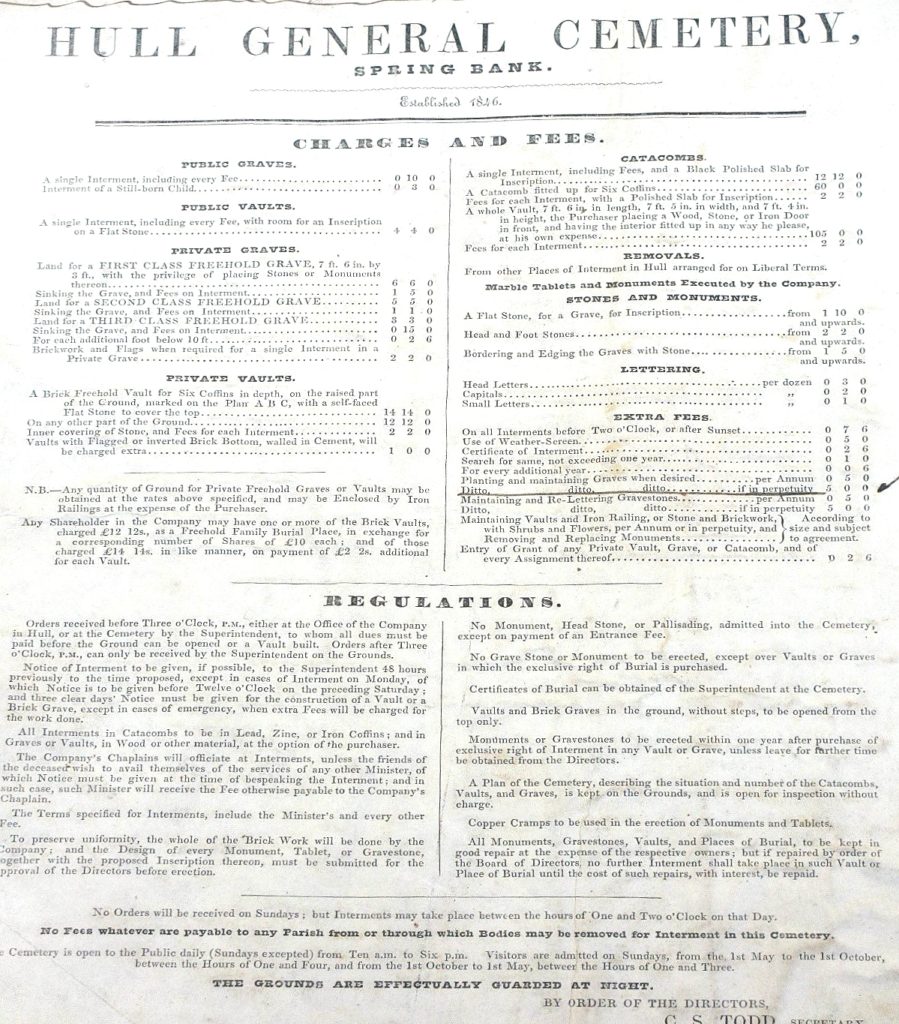
A week later, on the 28th April, an impressive funeral took place.
Undertaken by nearly 200 stonemasons of one of their brethren, the procession began at Carr Lane and proceeding up Spring Bank to the graveside. In some ways it set the tone for many other funerals that the Hull General Cemetery hosted over the next 130 years. Stonemason of the Cemetery
The official opening
Although the Cemetery was open for business, its official opening ceremony took place in the June of that year. It was an occasion of great pomp and ceremony with all of the local dignitaries being present.
The local press recorded the occasion.
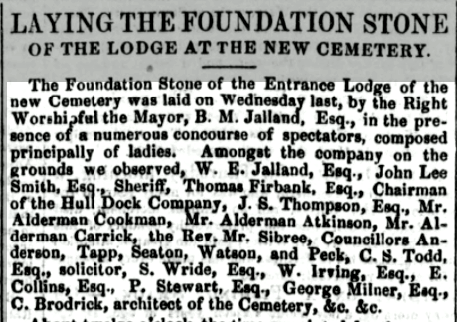
Various objects were interred within the foundation stone. The press recorded what these were.
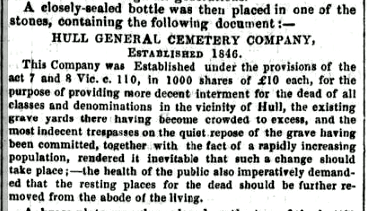
On top of the bottle was placed a brass inscribed plate.
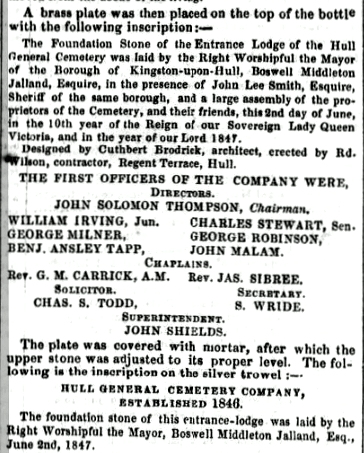
None of these items survived the demolition of the Lodge in 1927 except for one. This was a list of the original shareholders. It’s held now in Hull History Centre.
However, there may be one other item from this ceremony that survives.
As stated above, the Mayor, Mr Jalland, laid the foundation stone of the lodge ‘in the presence of a numerous concourse of spectators, principally of ladies,’ on the 2nd of June 1847.
Where is the trowel?
In laying the foundation stone he used an inscribed silver trowel as stated above. This trowel was specially made for this occasion.
In the minute books of the Company it is mentioned.
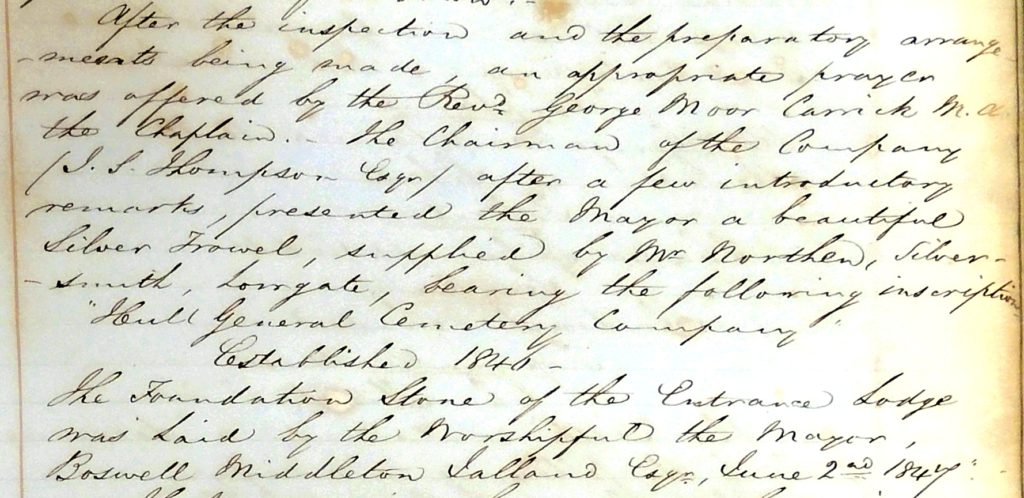
The silver trowel, made by Mr Northern of Lowgate, was presented to the Mayor.
It is my belief that it still resides in some cupboard or cellar within the Guildhall. A tangible reminder of the day that Hull began to dispose of it’s dead with dignity.
The Foundation stone was laid. And now there were, as usual, a number of speeches. Following those was a brief prayer by Rev. James Sibree. He would later write so movingly about his time spent in the Cemetery during the Cholera outbreak in 1849.
Finally, as the Hull Packet, almost apologetically recorded, ‘and the doxology having been sung, the assembly dispersed.‘
The end of the cemetery
After a long and hard struggle, with one or two missteps along the way, Hull now had a cemetery. The cemetery it had needed for the past thirty years. It served the community well for the next century or so.
By the time I was kicking through the fallen leaves on my way to Hull Fair it had long given up its pre-eminent place for burials to the municipal cemeteries. It became secluded and a haven for wildlife. Its wilderness appealed to the poetic and the historian. Its decay appeared to enhance its beauty. It wore its shabbiness with a genteel pride. No amount of skilful artifice could have manufactured it.
In 1972 the Hull General Company was finally wound up.
The final burial, of an urn of ashes, took place in 1974. I worked with the man who interred it. I can show you where this happened.
Some five years later the clipboards and the bulldozers of the Council moved in. An historic part of our shared heritage was destroyed. In about an 18 month period, what had taken over 130 years to produce, was gone. And to create…what? A Monumental Loss
Welcome to Hull, City of Culture 2017.
Isn’t it one of the paradoxes of life that what was once thought to be unimportant becomes very important but only when you’ve lost it?

Pete Lowden is a member of the Friends of Hull General Cemetery committee which is committed to reclaiming the cemetery and returning it back to a community resource.

